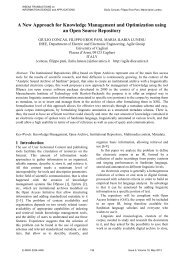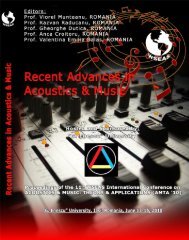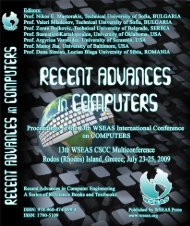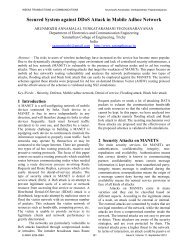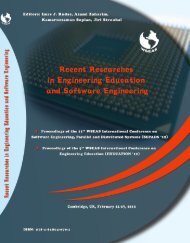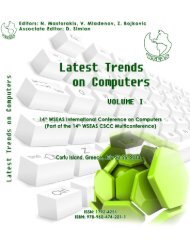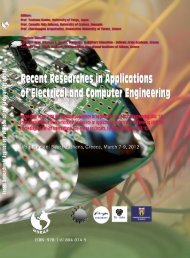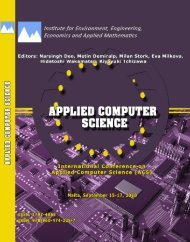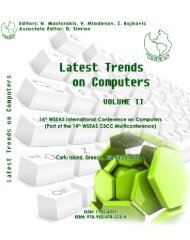RECENT ADVANCES in CIRCUITS, SYSTEMS, SIGNAL ... - Wseas.us
RECENT ADVANCES in CIRCUITS, SYSTEMS, SIGNAL ... - Wseas.us
RECENT ADVANCES in CIRCUITS, SYSTEMS, SIGNAL ... - Wseas.us
Create successful ePaper yourself
Turn your PDF publications into a flip-book with our unique Google optimized e-Paper software.
<strong>RECENT</strong> <strong>ADVANCES</strong> <strong>in</strong> <strong>CIRCUITS</strong>, <strong>SYSTEMS</strong>, <strong>SIGNAL</strong> and TELECOMMUNICATIONS<br />
Plenary Lecture 3<br />
Generalized Optimization for Analog Network Design<br />
Professor Alexander Zemliak<br />
Autonomo<strong>us</strong> University of Puebla, Mexico<br />
National Technical University of Ukra<strong>in</strong>e, Kiev<br />
Ukra<strong>in</strong>e<br />
E-mail: azemliak@yahoo.com<br />
Abstract: An approach of the generalized optimization for analog network design was elaborated by means of the<br />
optimum control theory formulation. This methodology generalizes the design process and generates a set of<br />
different design strategies that serves as a structural basis for the m<strong>in</strong>imal-time design strategy construction. The<br />
ma<strong>in</strong> conception of this approach is the <strong>in</strong>troduction of special control functions, which, on the one hand generalize<br />
the design process and, on the other hand, they give the possibility to control the design process to achieve the<br />
optimum of the design cost function for the m<strong>in</strong>imal computer time. This possibility appears beca<strong>us</strong>e of <strong>in</strong>f<strong>in</strong>ite<br />
number of different design strategies that exist with<strong>in</strong> the bounds of the new theory. In this case a new quality<br />
appears due to the possibility of controll<strong>in</strong>g the design process by redistribut<strong>in</strong>g computational expense between the<br />
circuit’s analysis and the procedure of parametric optimization. The problem of m<strong>in</strong>imal-time network design strategy<br />
is formulated as a typical problem for some functional m<strong>in</strong>imization of the control theory. The network optimization<br />
process <strong>in</strong> this case is def<strong>in</strong>ed as a controllable dynamic system.<br />
An additional acceleration effect was discovered on the basis of new approach and it permits <strong>us</strong> the reduc<strong>in</strong>g of the<br />
computer design time additionally and serves as one of the fundamental notions for construct<strong>in</strong>g the quasi-optimaltime<br />
design algorithm. This effect can be realized by means of chang<strong>in</strong>g of one design strategy to other with a special<br />
selection of the <strong>in</strong>itial po<strong>in</strong>t of optimization process. Practical optimization of the different electronic networks shows<br />
that the potential computer time ga<strong>in</strong> of the optimal strategy grows when the size and complexity of a network<br />
<strong>in</strong>crease.<br />
The conception of the Lyapunov function of the design process serves as one of the productive ideas to study the<br />
ma<strong>in</strong> properties of the time-optimal design algorithm. The Lyapunov function and its time derivative <strong>in</strong>clude the<br />
sufficient <strong>in</strong>formation to select more perspective design strategies from all of the different design strategies that exist<br />
<strong>in</strong> bounds of generalized optimization methodology. Analysis of behavior of the Lyapunov function dur<strong>in</strong>g the<br />
optimization process shows a strong correlation between some characteristics of this function and a processor time. It<br />
means that the study of the Lyapunov function of design process helps <strong>us</strong> construct<strong>in</strong>g the structure of the m<strong>in</strong>imaltime<br />
network design algorithm.<br />
Brief Biography of the Speaker:<br />
Alexander Zemliak received the M.S. degree <strong>in</strong> electronic eng<strong>in</strong>eer<strong>in</strong>g from the Kiev Polytechnic Institute (KPI), Kiev,<br />
Ukra<strong>in</strong>e, <strong>in</strong> 1972 and <strong>in</strong> mathematics from the Kiev University <strong>in</strong> 1975, and Ph.D. <strong>in</strong> electronic eng<strong>in</strong>eer<strong>in</strong>g from KPI <strong>in</strong><br />
1976. He is currently a Professor of Physics and Mathematics Department, Autonomo<strong>us</strong> University of Puebla, and a<br />
Professor of the National Technical University of Ukra<strong>in</strong>e "KPI" too. His research <strong>in</strong>terests are <strong>in</strong> computer-aided RF<br />
and microwave circuit analysis, optimal design methodologies, computational electromagnetics, numerical techniques<br />
<strong>in</strong> the simulation, analysis and optimization of microwave devices. He has authored of two books, 6 chapters of books<br />
and over 250 papers <strong>in</strong> refereed journals and conference proceed<strong>in</strong>gs. From 1986 to 1994 he held some research<br />
grants from M<strong>in</strong>istry of Superior Education of Ukra<strong>in</strong>e and <strong>in</strong>d<strong>us</strong>try. From 1998 to 2009 he held some grants from<br />
Mexican National Council of Science and Technology. He is a member of Ukra<strong>in</strong>ian Scientific Society, National<br />
System of Investigators of Mexico, Senior Member of IEEE, member of IEICE, WSEAS and New York Academy of<br />
Sciences. He was a chairman of some <strong>in</strong>ternational conferences <strong>in</strong> Mexico, member of technical program committee<br />
of some conferences around the world and <strong>in</strong>vited lecturer of more than 10 <strong>in</strong>ternational conferences. He obta<strong>in</strong>ed<br />
best paper award at National SOMI Conference, 1999 (Mexico), International conference IBERCHIP, 2002 (Mexico),<br />
International WSEAS Conference, 2009 (Turkey), International Conference IEEE EWDTS, 2009 (R<strong>us</strong>sia). He is<br />
Editor-<strong>in</strong>-Chief of the WSEAS Transactions on Systems, Member of the Editorial Board of the WSEAS Transactions<br />
on Circuits and Systems, WSEAS Transactions on Electronics. He was a Reviewer of International Design<br />
Automation Conference-DAC, 2001–2003, USA; International Conference on Comput<strong>in</strong>g, Communication and<br />
ISSN: 1790-5117 16 ISBN: 978-960-474-152-6




